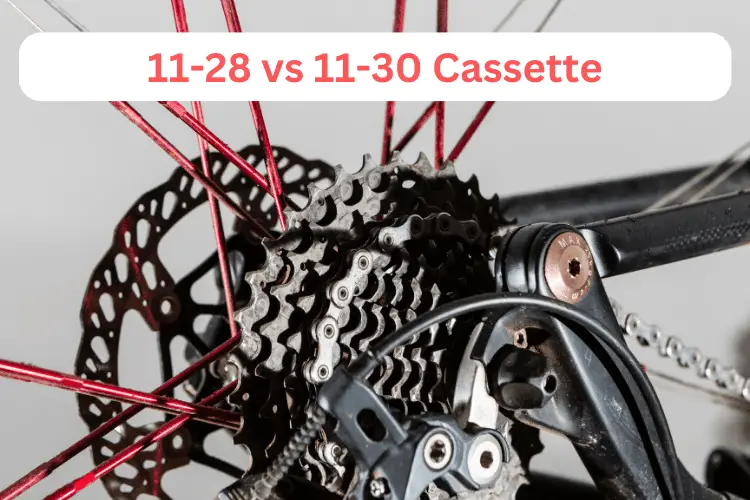Understanding how your gears work on the surface is easy. With one push of the lever, you can pedal easily and move. However, choosing the right gear to install, on the other hand, is where there are usually problems.
The standard gearing setup on road bikes is an 11-28 cassette with a 50/34 chainset.
The small and big chainrings have 34 and 50 teeth. While the cassette’s largest cog has 28 teeth, and the smallest has 11 teeth.
This setup has a range where the shortest gear combination has 14.1km/h speed and a 90 rpm cadence. The tallest gear combination has a 52.8km/h speed.
What happens if you can’t sustain 14.1 km/h speed while climbing and don’t want to reduce your cadence?
In this article, we’ll discuss the difference between 11-28 and 11-30 and if you can use the same chain length on both cassettes.
Quick Navigation
What is an 11-28 Cassette?
The 11-28 cassette is one of those clusters of sprockets you attach to your bike’s rear hub. It comes with an average speed of 14.1 km/hr.

This cassette combines cogs of different sizes (from 11 to 28) hence the name.
The first number represents the number of teeth on the smallest sprockets. The smallest sprocket is the highest gear in the combination for pedaling at a fast speed.
The second number represents the number of teeth on the biggest sprockets. The biggest sprocket is the lowest gear, and it’s used for climbing hills.
We have another article on Why Is My Cassette Wobbling?
What is an 11-30 Cassette?
Typical 11-30 bike cassettes consist of another set of sprockets fixed to the rear hub of a bike. With this cassette, you can hit an average speed of 13.2km/hr.

The 11-30 cassette has cogs of different sizes, starting at size 11 and going up to size 30. The cassette’s first teeth are 11, 12, 13, 14, 15, and 17.
The numbers 19 and 21 are middle carriers, and the middle cogs are fiber reinforced. This set of cogs is metallic and made from steel.
The last sets are the largest trio. They come in sizes 24, 27, and 30. They are made of steel with spider aluminum plating.
You can use this cassette on any setup. Additionally, it is perfect for Shimano Ultegra Speed of 11-speed systems.
Difference Between 11-28 and 11-30 Cassette
Here are the differences between the 11-28 and the 11-30 cassettes.
| Features | 11-28 Cassettes | 11-30 Cassettes |
|---|---|---|
| Speed | Standard gearing setup on road bikes with a good range for increased speed | Large cogs for road bikes used to decrease speed |
| Sprocket | The largest sprocket is 28 | The largest sprocket is 30 |
| Cadence | The average change in cadence for the 11-28 cassette is 90 rpm | The average change in cadence for the 11-30 cassette is 80 rpm |
| Transition | Come with smaller jumps between the gears which makes shifting transitions better | Come with more significant jumps between gears to enable the rider to maintain transition while climbing a hill |
| Cogs | They have corresponding small cogs for the first set | They have smaller corresponding cogs for the first set |
| Gear | Its lowest gear is not as common as that of 11-25 | Its lowest gear in not as low as that of 11-34 |
Can I Use The Same Chain Length on an 11-28 as an 11-30?
Yes you can. However, you will have to test the chain length on the largest cog (back and front) to see if it will run smoothly.
When testing the chain length, you’ll have to see if the derailleurs still function correctly. Put the chain on the largest cog in the front and the third largest in the back.
At this point, the derailleurs will not be stretched out to their maximum length. Shift the chain carefully to 30 and try to pedal. If the chain begins to bind up, it’s not long enough.
Please don’t force it. You can end up damaging the front derailleur. You can get a new chain to use or add additional links depending on the chain’s newness.
It is advisable to buy a new chain when changing cassettes. The reason is that a new chain has a long distance below its rollers.
Don’t miss to read our How To Untangle A Bike Chain (Ultimate Guide)
Is an 11-28 good for climbing?
Yes, An 11-28 cassette is suitable for climbing but not best. Some riders use it to chart the mountain course. However, 11/32 and 11/34 cassettes are best suited hill climbing.

The 11-28 is a preferred option for many riders who ride up a mountain. These mountains are big, so they require a considerable climb and are often very steep.
They use the 11-28 to climb the mountain or hilly road so they don’t get tired, blow up on the rise, and control their cadence and effort.
If you’re a beginner in mountain climbing, you should start with the 11-32 cassette to master high cadence. The 11-28 is for riders with experience and strength in this sport.
Is an 11-34 good for climbing?
An 11-34 cassette is suitable for hiking or climbing mountainous areas. The extensive range in the cog sizes makes it easier to ride an 11-34 in such areas.
The 11-34 is the most preferable for climbing among all bicycle gear. Many riders choose this option because it gives you the most accessible gear and makes pedaling easier.
To make pedaling easy, there must be a massive leap in the cogs from 30-34. Ordinarily, switching from 30-34 is quite tricky.
However, with enough practice, you will get used to it and can pull it off without stress.
Mastering that switching act will be helpful to you when climbing mountains. Knowing how to stay balanced and when to switch during climbing makes using the 11-34 better.
If you’re looking to upgrade your bike cassettes for climbing purposes, upgrade to the 11-34, as that’s the best option for climbing.
Final Thoughts
Both cassettes are great choices if you’re considering which one to use. An 11-28 is the standard gear setup on road bikes.
If you’re a beginner, you should use fewer gear than the 11-28.
An 11-30 is a modern product with excellent features. You can start with this to master the cadence level.
Among all the 11-34 is the most upgraded version and will give you balance while you ride.

1 thought on “11-28 vs 11-30 Cassette : Comparison and Analysis”